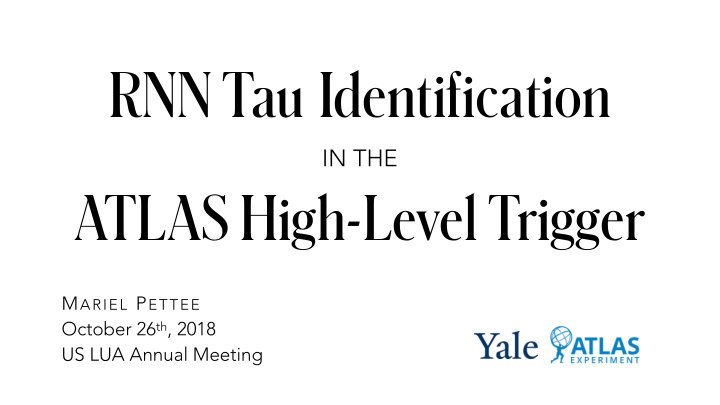



RNN Tau Identi f ication IN THE ATLAS High-Level Trigger M ARIEL P ETTEE October 26 th , 2018 US LUA Annual Meeting
� 2
BDT 𝜐 Identi f ication � 3
BDT Tau Identi f ication ‣ BDT = Boosted Decision Tree ‣ Inputs: 12 “high-level” tau ID variables 1-prong 3-prong ‣ Separate models for 1- and 3-prong taus Central energy fraction • Transverse • E T / p T of leading Mean track radius flight path charged track Momentum fraction significance • Significance of of isolation tracks • Maximum Δ R leading track Momentum ratio of transverse impact • Mass of track + EM system parameter charged tracks Energy flow p T ratio Energy flow mass Table: ATLAS-CONF-2017-061 4 �
BDT Tau Identi f ication arXiv:1704.07657 https://xkcd.com/210/ ‣ After training, classify each tau candidate with a single score ∈ (0,1): 0 = background-like 1 = signal-like � 5
BDT Tau Identi f ication BDT Tau ID Performance in the HLT (2017) Benefits of the BDT architecture: ‣ Highly-optimized classification ‣ Physical intuition & insight But... are we throwing away information by only considering these select high-level variables? Could adding low-level input variables into the mix improve our signal/background discrimination? Plot: ATLAS-CONF-2017-061 � 6
RNN 𝜐 Identi f ication � 7
RNN Tau Identi f ication ‣ RNN = Recurrent Neural Network ‣ Approaches 𝜐 identification as a sequence classification problem ‣ Inputs: - Track-level variables (for at most 10 tracks; full list in backup slides) - Cluster-level variables (for at most 6 clusters; full list in backup slides) - BDT input variables Reconstructed hadronic tau decay RNN Output neuron ( p T ∆ η ∆ ϕ d 0 Track 1 . . . B S Dense layer with shared weights p T ∆ η ∆ ϕ d 0 Track 2 . . . Ordered by p T . . . . . . p T ∆ η ∆ ϕ d 0 Track N . . . 8 � Image: C. Deutsch
Images: C. Deutsch RNN Tau Identi f ication = Variables Input BDT � 9 + Reconstructed hadronic tau decay RNN ( p T Clusters ∆ η ∆ ϕ d 0 Track 1 . . . Dense layer with shared weights p T ∆ η ∆ ϕ d 0 Track 2 . . . . . . . . . p T ∆ η ∆ ϕ d 0 Track N . . . + Reconstructed hadronic tau decay RNN ( p T ∆ η ∆ ϕ d 0 Track 1 . . . Tracks Dense layer with shared weights p T ∆ η ∆ ϕ d 0 Track 2 . . . . . . . . . p T ∆ η ∆ ϕ d 0 Track N . . .
RNN Tau Identi f ication ‣ Shared dense & LSTM (Long Short-Term Memory) layers preserve contextual information from multiple tracks/clusters to improve decision-making Cell state Input #1 Input #2 Input #3 � 10 Image: http://colah.github.io/posts/2015-08-Understanding-LSTMs/ Image: C. Deutsch
RNN Tau Identi f ication ‣ BDT 𝜐 identification: 1-prong and 3-prong taus ‣ RNN 𝜐 identification: 0-prong, 1-prong and ≥ 2-prong taus Goal: recover true 1p taus for Goal: recover true 3p taus for which the charged track has been which at least one charged track has poorly reconstructed, especially at been mis-reconstructed. low-p T and high- μ . � 11 Image: C. Deutsch
RNN Tau Identi f ication: Online ‣ Training samples: ‣ γ * → 𝜐𝜐 and dijets ‣ Fewer statistics than for offline, but same # of trainable parameters ‣ 0-prong: Signal ~100k events, Background ~50k events ‣ 1-prong: Signal ~2M events, Background ~175k events ‣ ≥ 2-prong: Signal ~700k events, Background ~3M events ‣ Reweight signal p T spectrum to match background p T spectrum for determining same-rejection working points as the BDT (since trigger rates are dominated by low-p T jets ). � 12
RNN Tau Identi f ication: Outlook ‣ RNN tau identification successfully deployed in the ATLAS high-level trigger in mid-2018! (Public results forthcoming) ‣ Will likely be the default ATLAS tau identification algorithm in the Run 3 trigger ‣ Until then: Continue optimizing models • Investigate RNN input variable modeling • Consider training on data rather than MC • � 13
Backup Slides � 14
Tau ID RNN Input Variables - Track-level variables ‣ pt_log ‣ pt_jetseed_log # of tracker (pixel, SCT) hits → # of tracker hits + ‣ d0_abs_log ‣ z0sinThetaTJVA_abs_log # of dead sensors ‣ dEta • Designed to protect against varying ‣ dPhi detector conditions ‣ nIBLHitsAndExp ‣ nPixelHitsPlusDeadSensors ‣ nSCTHitsPlusDeadSensors # of IBL hits → If a hit is expected, use actual # - Cluster-level variables of IBL hits. If not, set # IBL hits = 1. • If # of IBL hits were set to 0 in the latter ‣ et_log ‣ pt_jetseed_log case, might be wrongly classified as a bad ‣ dEta track ‣ dPhi ‣ SECOND_R ‣ SECOND_LAMBDA ‣ CENTER_LAMBDA 15 �
Tau ID RNN Input Variables � 16
Tau HLT in 2018 CALORIMETER INITIAL PRECISION TAU CLUSTERING TRACKING TRACKING IDENTIFICATION ‣ Inclusive MVA TES: ‣ “Fast Track ‣ Track refit: ‣ RNN Finder” (FTF): MVA Tau Energy Scale Run precision 0-/1-/multi-prong RNN Look for a track in a calibration applied to tracking on FTF with tau ID variables + narrow cone (ΔR < 0.1) all tau candidates seeds track + cluster around the center of variables as inputs ‣ nTracks cut the cluster & along the ‣ Minimum p T cut full beam line nTracks Cut: only pass taus with… ✅ 1-3 tracks in core region ✅ ≤ 1 tracks in isolation region 17 �
Recommend
More recommend